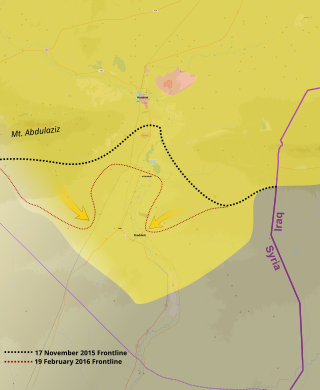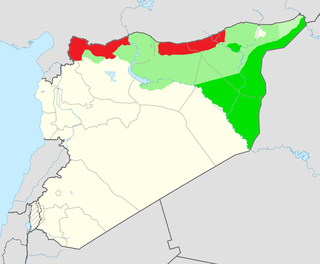
Tell Abyad is a town in northern Syria. It is the administrative center of the Tell Abyad District within the Raqqa Governorate. Located along the Balikh River, it constitutes a divided city with the bordering city of Akçakale in Turkey.

The Syriac Military Council is an Assyrian/Syriac military organisation in Syria, part of the Syrian Democratic Forces. The establishment of the organisation was announced on 8 January 2013. According to the Syriac Military Council, the goal of the organisation is to stand up for the national rights of and to protect Assyrians in Syria. It operates mostly in the densely populated Assyrian areas of Al-Hasakah Governorate, and is affiliated to the Syriac Union Party.

The Rojava–Islamist conflict, a major theater in the Syrian civil war, started after fighting erupted between the Kurdish People's Protection Units (YPG) and Islamist rebel factions in the city of Ras al-Ayn. Kurdish forces launched a campaign in an attempt to take control of the Islamist-controlled areas in the governorate of al-Hasakah and some parts of Raqqa and Aleppo governorates after al-Qaeda in Syria used those areas to attack the YPG. The Kurdish groups and their allies' goal was also to capture Kurdish areas from the Arab Islamist rebels and strengthen the autonomy of the region of Rojava. The Syrian Democratic Forces would go on to take substantial territory from Islamist groups, in particular the Islamic State of Iraq and the Levant, provoking Turkish involvement in the Syrian Civil War.

Liwa Thuwar al-Raqqa was a rebel group in the Syrian Civil War. It was formed in September 2012 in the Raqqa Governorate. Aligned with jihadist factions for its first years, at the end of 2015, it joined the Syrian Democratic Forces. During an interview by Aymenn Jawad Al-Tamimi in 2015, Liwa Thuwar al-Raqqa's media director stated that the group wants a "civil democratic state". He also claimed that the group had no relations with the Syrian National Coalition based in Turkey.

The Retribution Army was a Free Syrian Army (FSA)-affiliated group formed by Deir ez-Zor natives that fought in the Syrian Civil War against the government and the Islamic State of Iraq and the Levant (ISIL).

The Eastern al-Hasakah offensive was launched in the Al-Hasakah Governorate during the Syrian Civil War, by the Kurdish-majority People's Protection Units, Assyrian Christian militias, and allied Arab forces against the jihadist Islamic State of Iraq and the Levant, with the intent of retaking the areas of the Jazira Canton that had been captured by ISIL. Subsequently, the Syrian Armed Forces also launched an assault against the jihadists, without coordinating with the YPG.

The Tell Abyad offensive or Martyr Rubar Qamışlo operation was a military operation that began in late May 2015 in the northern Raqqa Governorate, during the Syrian Civil War. It was conducted by the Kurdish-majority People's Protection Units (YPG) and the Free Syrian Army (FSA) against the Islamic State of Iraq and the Levant. The offensive took place from the end of May until July 2015. The campaign was the second phase of the Kurdish Operation Commander Rûbar Qamishlo, which began with the Al-Hasakah offensive, and involved the merger of the Kobanî offensive with the former. The focus of the campaign was to capture the key border town of Tell Abyad, and to link the Kobanî and Jazira Cantons in Northern Syria.

The Syrian Democratic Forces (SDF) is a coalition of ethnic militias and rebel groups in North and East Syria (AANES). An alliance of forces formed during the Syrian civil war composed primarily of Kurdish, Arab, and Assyrian/Syriac, as well as some smaller Armenian, Turkmen and Chechen forces. It is militarily led by the People's Protection Units (YPG), a Kurdish militia recognized as a terrorist group by Turkey. SDF also includes several ethnic militias, and various factions of the Syrian opposition's Free Syrian Army. Founded in October 2015, the SDF states its mission as fighting to create a secular, democratic and federalised Syria. According to Turkey, the Syrian Democratic Forces has direct links to the PKK.

The Forces of the Brave, generally called the al-Sanadid Forces, are a militia formed by the Arab Shammar tribe to fight against the Islamic State. Even though the tribe's Syrian strongholds are mostly in the Jazira Canton of the Autonomous Administration of North and East Syria, such as at al-Yaarubiyah and Tell Hamis, the militia operates throughout most of the AANES. The red colour in their flag represents blood while the yellow represents the light, calling themselves “marchers on the red death”. The al-Sanadid Forces are affiliated with the co-governor/co-president of Jazira Canton and tribal leader Humaydi Daham al-Hadi, and are led by Humaydi's son Bandar al-Humaydi.

Ayn Issa is a town in the Tell Abyad District of Raqqa Governorate in Syria. It is located halfway between the Syria–Turkey border town of Tell Abyad and the regional capital Raqqa. Through the city runs the M4 highway connecting Aleppo with the Hasakah Governorate.

The al-Shaddadi offensive (2016), also known as Operation Wrath of Khabur, was an offensive launched by the Syrian Democratic Forces (SDF) during the Syrian Civil War, in February 2016. The main goal of this offensive was to capture the strategic city of Al-Shaddadi and the remainder of the southern al-Hasakah Governorate from the Islamic State of Iraq and the Levant (ISIL). During the offensive, the US-led coalition conducted more than 86 airstrikes in Al-Shaddadi and the nearby areas, in support of the SDF advances.
The Northern Raqqa offensive was a 2016 military offensive launched by the Kurdish-led Syrian Democratic Forces against the Islamic State of Iraq and the Levant in northern Raqqa Governorate, in order to prepare for a future attack on the city of Raqqa. The offensive was launched in coordination with airstrikes by the US-led Combined Joint Task Force – Operation Inherent Resolve. After 30 May, the offensive stalled, as the SDF shifted its focus and resources to another operation in the northern Aleppo Province.

The Syrian Democratic Forces (SDF) has many military councils for local security and defense, each being accountable to the civil council of the area they operate in.

The Raqqa campaign was a military operation launched in November 2016 during the Rojava–Islamist conflict by the Syrian Democratic Forces (SDF) against the Islamic State of Iraq and the Levant (ISIL) in the Raqqa Governorate, with the goal of isolating and eventually capturing the Islamic State's capital city, Raqqa. The SDF's subsidiary goals included capturing the Tabqa Dam, the nearby city of al-Thawrah, and the Baath Dam further downstream. The campaign ended successfully in October 2017, with the capture of Raqqa.
The following is a timeline of the Syrian Civil War from September to December 2017. Information about aggregated casualty counts is found at Casualties of the Syrian Civil War.

The Deir ez-Zor campaign, codenamed the al-Jazeera Storm campaign, was a military operation launched by the Syrian Democratic Forces (SDF) against the Islamic State of Iraq and the Levant (ISIL) in Syria's Deir ez-Zor Governorate in 2017 during the Syrian Civil War with the goal of capturing territory in eastern Syria, particularly east and north of the Euphrates river. The U.S.-led Combined Joint Task Force – Operation Inherent Resolve (CJTF–OIR) anti-ISIL coalition provided extensive air support while SDF personnel composed the majority of the ground forces; OIR special forces and artillery units were also involved in the campaign.
Opposition–ISIL conflict during the Syrian Civil War started after fighting erupted between Syrian opposition groups and the Islamic State of Iraq and the Levant (ISIL). In early January 2014, serious clashes between the groups erupted in the north of the country. Opposition groups near Aleppo attacked ISIL in two areas, Atarib and Anadan, which were both strongholds of the fundamentalist Sunni organization. Despite the conflict between ISIL and other rebels, one faction of ISIL has cooperated with the al-Nusra Front and the Green Battalion to combat Hezbollah in the Battle of Qalamoun. By 2018, the Islamic State was destroyed in the territories held by the opposition.

The Eastern Syria insurgency is an armed insurgency being waged by remnants of the Islamic State of Iraq and the Levant (ISIL) and both pro and anti-Syrian government Arab nationalist insurgents, against the Autonomous Administration of North and East Syria (AANES), its military, and their allies in the US-led Combined Joint Task Force – Operation Inherent Resolve (CJTF–OIR) coalition.
The following is a timeline of the Syrian civil war for 2021. Information about aggregated casualty counts is found at Casualties of the Syrian civil war.
The following is a timeline of the Syrian civil war for 2022. Information about aggregated casualty counts is found in Casualties of the Syrian civil war.














